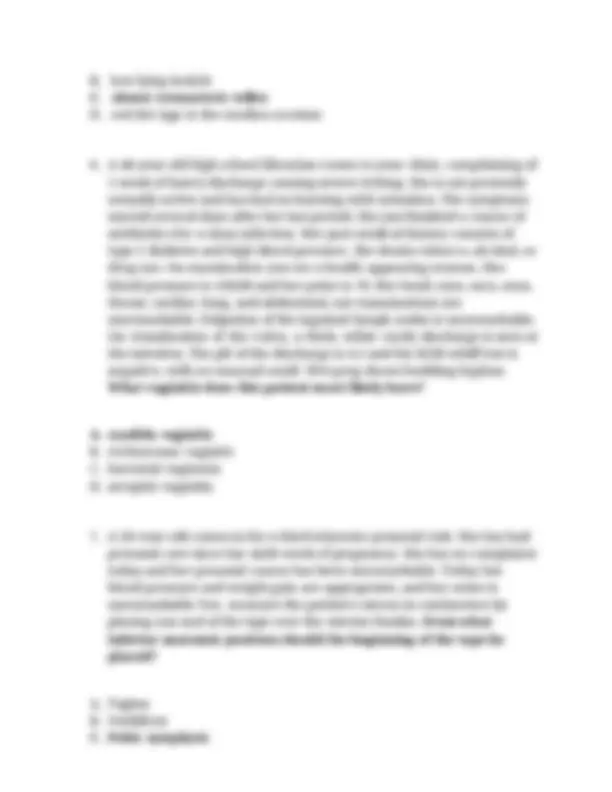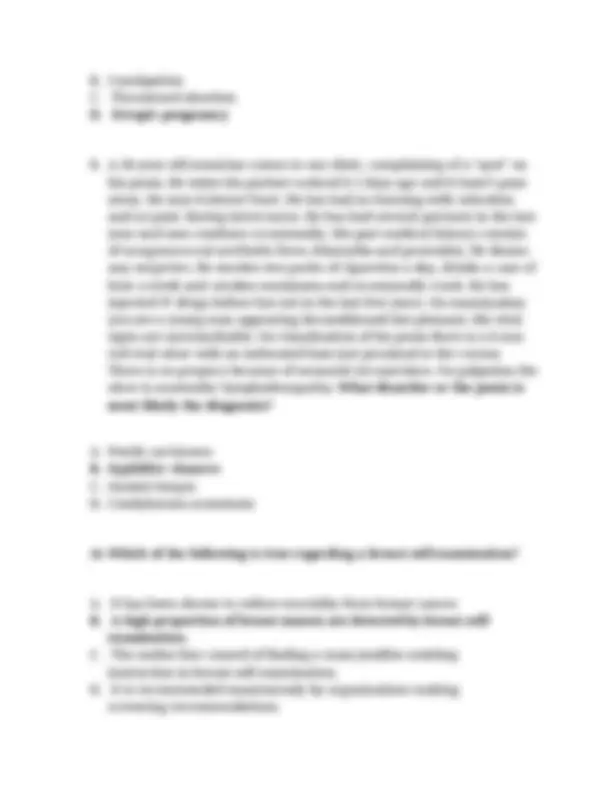





Study with the several resources on Docsity

Earn points by helping other students or get them with a premium plan


Prepare for your exams
Study with the several resources on Docsity

Earn points to download
Earn points by helping other students or get them with a premium plan
Community
Ask the community for help and clear up your study doubts
Discover the best universities in your country according to Docsity users
Free resources
Download our free guides on studying techniques, anxiety management strategies, and thesis advice from Docsity tutors
1. A 30-year-old male patient notices a firm 2-cm mass under his areola. He has no other symptoms and no diagnosis of breast cancer in his first-degree relatives. What is the most likely etiology of the mass? a. Lymph node b. Fibrocystic disease c. Breast cancer d. Breast tissue 2. A 47-year-old male complaining of fever, chills pelvic pain and difficulty urinating, and they suspect prostatitis. What assessment techniques should be avoided? A. Palpation of prostate during digital rectal exam B. Deep abdominal palpation C. Palpation of the epididymis D. Collection of urinalysis 3. An NP performing a pelvic exam on a woman that is 13 weeks pregnant would likely find the uterus, where the baby is located? Just rising above, beyond the pelvic bone.
Typology: Quizzes
1 / 5

This page cannot be seen from the preview
Don't miss anything!




1. A 30-year-old male patient notices a firm 2-cm mass under his areola. He has no other symptoms and no diagnosis of breast cancer in his first- degree relatives. What is the most likely etiology of the mass? a. Lymph node b. Fibrocystic disease c. Breast cancer d. Breast tissue
5. A 14-year-old male is seen with complaint of severe testicular pain for 2 hours. The Nurse Practitioner suspects testicular torsion. Which of the following is an expected positive examination finding? A. pain relieved with testicular elevation.
D. Clitoris
B. Constipation C. Threatened abortion. D. Ectopic pregnancy
9. A 28-year-old musician comes to our clinic, complaining of a "spot" on his penis. He states his partner noticed it 2 days ago and it hasn't gone away. He says it doesn't hurt. He has had no burning with urination and no pain during intercourse. He has had several partners in the last year and uses condoms occasionally. His past medical history consists of nongonococcal urethritis from chlamydia and prostatitis. He denies any surgeries. He smokes two packs of cigarettes a day, drinks a case of beer a week and smokes marijuana and occasionally crack. He has injected IV drugs before but not in the last few years. On examination you see a young man appearing deconditioned but pleasant. His vital signs are unremarkable. On visualization of his penis there is a 6-mm red oval ulcer with an indurated base just proximal to the corona There is no prepuce because of neonatal circumcision. On palpation the ulcer is nontender lymphadenopathy. What disorder or the penis is most likely the diagnosis? A. Penile carcinoma B. Syphilitic chancre C. Genital herpes D. Condylomata acuminata 10. Which of the following is true regarding a breast self-examination? A. It has been shown to reduce mortality from breast cancer. B. A high proportion of breast masses are detected by breast self- examination. C. The undue fear caused of finding a mass justifies omitting instruction in breast self-examination. D. It is recommended unanimously by organizations making screening recommendations.